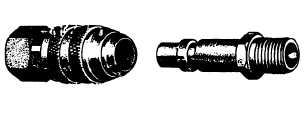SEGMENTED SOCKET, RING AND
BAND ATTACHED.— The segmented, ring and
band attached socket consists of three or more
segments. As with the bolt-together segments, the
segments, ring and band are put on the hose after
insertion of the nipple. A special tool is required
to compress the segments.
SEGMENTED SOCKET, RING AND BOLT
ATTACHED.— The segmented, ring and bolt
attached socket consists of three or more
segments. As with other segmented socket-type
fittings, the segments, ring, and nuts and bolts
are put on the hose after insertion of the nipple.
SOLID SOCKET, PERMANENTLY
ATTACHED.— This type of socket is perma-
nently attached to the hose by crimping or
swaging. It is not reusable and is only found
on hose assemblies where operating conditions
preclude the use of other fitting types. Hose
assemblies with this type of fitting attachment are
purchased as complete hose assemblies from the
manufacturer.
QUICK-DISCONNECT COUPLINGS
Self-sealing, quick-disconnect couplings are
used at various points in many fluid power
systems. These couplings are installed at locations
where frequent uncoupling of the lines is required
for inspection, test, and maintenance. Quick-
disconnect couplings are also commonly used in
pneumatic systems to connect sections of air hose
and to connect tools to the air pressure lines. This
provides a convenient method of attaching and
detaching tools and sections of lines without losing
pressure.
Quick-disconnect couplings provide a means
for quickly disconnecting a line without the loss
of fluid from the system or the entrance of
foreign matter into the system. Several types of
quick-disconnect couplings have been designed for
use in fluid power systems. Figure 5-23 illustrates
Figure 5-23.—Quick-disconnect coupling for air lines.
a coupling that is used with portable pneumatic
tools. The male section is connected to the tool
or to the line leading from the tool. The female
section, which contains the shutoff valve, is
installed in the pneumatic line leading from
the pressure source. These connectors can be
separated or connected by very little effort on the
part of the operator.
The most common quick-disconnect coupling
for hydraulic systems consists of two parts, held
together by a union nut. Each part contains a
valve which is held open when the coupling is
connected, allowing fluid to flow in either
direction through the coupling. When the
coupling is disconnected, a spring in each part
closes the valve, preventing the loss of fluid and
entrance of foreign matter.
MANIFOLDS
Some fluid power systems are equipped with
manifolds in the pressure supply and/or return
lines. A manifold is a fluid conductor that
provides multiple connection ports. Manifolds
eliminate piping, reduce joints, which are often
a source of leakage, and conserve space. For
example, manifolds may be used in systems that
contain several subsystems. One common line
connects the pump to the manifold. There are
outlet ports in the manifold to provide con-
nections to each subsystem. A similar manifold
may be used in the return system. Lines from the
control valves of the subsystem connect to the inlet
ports of the manifold, where the fluid combines
into one outlet line to the reservoir. Some
manifolds are equipped with the check valves,
relief valves, filters, and so on, required for the
system. In some cases, the control valves are
mounted on the manifold in such a manner that
the ports of the valves are connected directly to
the manifold.
Manifolds are usually one of three types—
sandwich, cast, or drilled. The sandwich type is
constructed of three or more flat plates. The
center plate (or plates) is machined for passages,
and the required inlet and outlet ports are drilled
into the outer plates. The plates are then bonded
together to provide a leakproof assembly. The cast
type of manifold is designed with cast passages
and drilled ports. The casting may be iron, steel,
bronze, or aluminum, depending upon the type
of system and fluid medium. In the drilled type
of manifold, all ports and passages are drilled in
a block of metal.
5-19

